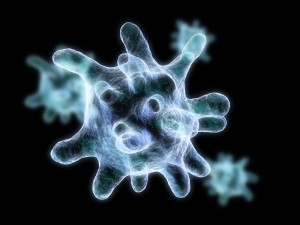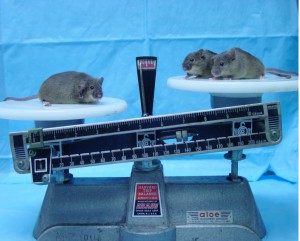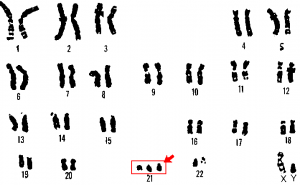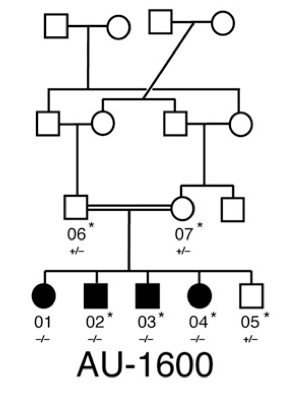
Giving patients the right kind of immune cells could curb their IBD, research suggests.
Inflammatory bowel disease (IBD) is miserable for anyone, but when it strikes a child under age 5, it’s much more severe, usually causing bloody diarrhea, wrenching abdominal pain and stunted growth. Early-onset IBD is rare, but on the rise: For reasons unknown, its incidence is increasing by about 5 percent per year in some parts of the world.
A recently identified form of early-onset IBD shows up within months of birth, causing severe inflammation in the large intestine and abscesses around the anus. Recently linked to genetic mutations in the cellular receptor for a signaling protein, interleukin-10 (IL-10), it can also lead to lymphoma later in life.
As with all early-onset IBD, IL-10-receptor deficiency has no good treatment. A bone marrow transplant is actually curative, but carries many risks, especially in infants.
“We’ve been trying to understand why IBD in these children is so severe and presents so early,” says Dror Shouval, MD, a pediatric gastroenterologist at Boston Children’s Hospital and a fellow in the lab of Scott Snapper, MD, PhD. The beginnings of such an understanding—detailed recently in the journal Immunity—could lead to a new treatment approach for this and perhaps other kinds of early-onset IBD. Full story »
 Last November, the U.S. Food and Drug Administration issued a “cease and desist” order to 23andMe, a major purveyor of direct-to-consumer (DTC) genetic testing. In its letter to the company—issued after three prior warnings—the FDA reiterated its view that 23andMe’s Personal Genome Service (PGS) constitutes a medical device requiring further premarket evaluation:
Last November, the U.S. Food and Drug Administration issued a “cease and desist” order to 23andMe, a major purveyor of direct-to-consumer (DTC) genetic testing. In its letter to the company—issued after three prior warnings—the FDA reiterated its view that 23andMe’s Personal Genome Service (PGS) constitutes a medical device requiring further premarket evaluation:
FDA is concerned about the public health consequences of inaccurate results from the PGS device…we still do not have any assurance that the firm has analytically or clinically validated the PGS for its intended uses.
The FDA’s order, based on potential rather than actual medical harm, has generated a great deal of controversy. In a recent critique published in Nature, Robert Green, MD, MPH, of the Partners HealthCare Center for Personalized Genetic Medicine, and Nita Farahany, PhD, JD, of the Duke Institute for Genome Sciences and Policy, argued against regulating DTC genomic interpretation services as medical devices:
… doing so could put FDA regulations in greater tension with the First Amendment of the US Constitution, which protects the rights of individuals to receive information, and of ‘commercial speech’ ….the agency should avoid restricting consumer genomic testing unless faced with empirical evidence of harm. Full story »

The Sylvian fissure (via BodyParts3D/Wikimedia Commons)
Five people with an unusual pattern of brain folds have afforded a glimpse into how the human brain may have evolved its language capabilities.
How the human brain develops its hills and valleys—expanding its surface area and computational capacity—has been difficult to study. Mice, the staple of scientific research, lack folds in their brains.
Christopher Walsh, MD, PhD, head of the Division of Genetics and Genomics at Boston Children’s Hospital, runs a brain development and genetics clinic and has spent 25 years studying people in whom the brain formation process goes awry. Some brains are too small (microcephaly). Some have folds, or gyri, that are too broad and thick (pachygyria). Some are smooth, lacking folds altogether (lissencephaly). And some have an abnormally large number of small, thin folds—known as polymicrogyria.
In 2005, studying people with polymicrogyria, Walsh and colleagues identified a mutation in a gene known as GPR56, a clue that this gene helps drive the formation of folds in the cortex of the human brain.
In a study published in today’s issue of Science, Walsh and his colleagues focused on five people whose brain MRIs showed polymicrogyria, but just in one location—near a large, deep furrow known as the Sylvian fissure, which includes the brain’s primary language area. Full story »

Three clinics are pre-testing children for genetic variants likely to affect their response to drugs.
In 2009,
The New England Journal of Medicine reported the
case of an otherwise healthy 2-year-old boy in Canada who died after surgery. He had received a codeine dose in the recommended range, but an autopsy revealed that morphine (a product of codeine metabolism) had built up to toxic levels in his blood and likely depressed his breathing. Genetic profiling revealed him to be an “ultrarapid codeine metabolizer,” due to a genetic variation in an enzyme known as CYP2D6, part of the cytochrome P-450 family.
While codeine is no longer used at Boston Children’s Hospital, it’s this kind of genetic profiling that Shannon Manzi, PharmD, would someday like to offer to all patients—before a drug is prescribed.
Not all people respond the same way to drugs. The results of randomized clinical trials—considered the gold standard for drug testing—often produce a dose range that worked for the majority of the patients in the study. They don’t take people’s individuality into account, and that individuality can dramatically affect drug efficacy and toxicity.
Adverse reactions are more common than you might think. Full story »

(Diane Campbell Payne, used with permission)
Naomi Fried, PhD, is chief innovation officer at Boston Children’s Hospital. This post is adapted from her remarks at the Connected Health Symposium on October 24, 2013. She tweets @NaomiFried.
In the health care industry, we rely heavily on regulations to ensure the safety of our patients, procedures and drugs. New national health care regulations can even spur innovation in care delivery, but in the case of telehealth, they can be an impediment.
Telehealth, the remote delivery of care via computers, mobile devices, videoconferencing and other technologies, has great potential to improve the patient experience and reduce health care costs by removing the barriers of brick and mortar. At Boston Children’s Hospital, the Innovation Acceleration Program’s pilot telehealth programs have focused on both direct patient care and virtual clinician-to-clinician consultations.
Unfortunately, most states’ regulations are limiting providers’ ability to broadly offer telehealth services. Full story »

A mechanosensory hair bundle in the cochlea. Each sensory cell, of which the human ear has about 16,000, has tiny hairs tipped with TMC1 and TMC2 proteins. When sound vibrations strike the bundle, it wiggles back and forth, opening and closing the TMC channels. When open, the channel allows calcium into the cell, initiating an electrical signal to the brain relayed by the 8th cranial nerve. (Image: Yoshiyuki Kawashima)
Ending a 30-year search by scientists, researchers have identified two proteins in the inner ear that are critical for hearing, which, when damaged by genetic mutations, cause a form of delayed, progressive hearing loss.
The proteins are essentially transducers: They form channels that convert mechanical sound waves entering the inner ear into electrical signals that talk to the brain. Corresponding channels for each of the other senses were identified years ago, but the sensory transduction channel for both hearing and the sense of balance had been unknown.
The channels are the product of two related genes known as TMC1 and TMC2. TMC1 mutations were first reported in people with a prominent form of hereditary deafness back in 2002 by Andrew Griffith, MD, PhD, of the National Institute on Deafness and Other Communication Disorders (NIDCD) and collaborators. Children with recessive mutations in TMC1 are completely deaf at birth. Full story »

Could the tendency toward weight gain in the mouse at left help explain some human obesity?
Two mice scurry around in an enclosure crossed through with light beams. The beams track their movement to measure their energy expenditure, along with the amount of oxygen they breathe in and carbon dioxide they exhale. The mice, who are siblings, are equally active and are held to the same diet, but there’s one critical difference: One mouse is noticeably heavier than the other.
“These [heavier] mice aren’t burning the fat,” says Joseph Majzoub, MD, chief of endocrinology at Boston Children’s Hospital. “They’re somehow holding onto it.”
In fact, the mice have to be underfed by 10 to 15 percent just to stay as slim as their siblings. Their experiences seem to parallel those of people who complain of gaining weight even when they don’t eat more than others. When allowed to eat as much as they want, the mice quickly begin to eat three to four times as much as the others and balloon to more than twice their size. Full story »

Researchers have silenced the third copy of chromosome 21, at least in a dish. What might this mean for Down syndrome? (Wikimedia Commons)
Emily Jean Davidson, MD, MPH, is clinical director of the Down Syndrome Program at Boston Children’s Hospital. Walter Kaufmann, MD, and David Stein, PsyD, research co-directors for the Down Syndrome Program, contributed to this post, along with Nicole Baumer, MD, fellow in Neurodevelopmental Disabilities, and Down Syndrome Program Coordinator Angela Lombardo, BA.
Last week, researchers at the University of Massachusetts published a fascinating and important study on Down syndrome in Nature. Lisa Hall, PhD, Jeanne Lawrence, PhD, and their colleagues were able to effectively “shut down” the gene activity of one of the three copies of the 21st chromosome in cells with trisomy 21.
What exactly did they do? The research team started with skin cells from a man with trisomy 21 that were transformed into induced pluripotent stem cells—cells that act like cells from an embryo and can develop into different cell types. They then took a gene from the X chromosome that is responsible for making sure that only one X chromosome is active in females—the X-inactivation gene—and inserted it in a specific location on chromosome 21. Full story »

Whole-exome sequencing reveals a gene mutation that comes into play only if inherited from the father.
For a small subset of boys and girls who undergo early puberty, there’s now a specific explanation. New genetic research, involving whole-exome sequencing, has identified four novel heterozygous mutations in a gene known as
MKRN3. Interestingly, while precocious puberty is more common in girls, all 15 affected children in the study inherited the mutations from their fathers.
Precocious puberty—the development of secondary sexual characteristics before 8 years in girls and 9 years in boys—has been associated with short stature, long-term health risks and an increase in conduct and behavioral disorders during adolescence. Physiologically, there are two types: central and peripheral. Central, the more common form, occurs when the pituitary gland, which controls puberty development, is activated too early.
“While a great deal of genetic studies have focused on the overall genetic contribution to pubertal timing, far less research has been conducted to find specific genetic causes of central precocious puberty,” says Andrew Dauber, MD, MMSc, of the Division of Endocrinology at Boston Children’s Hospital, who co-authored the study, published online this week by The New England Journal of Medicine. Full story »

In this family with 4 children with autism, genetic mapping and whole-exome sequencing identified a mutation in SYNE1, a gene that's known but never before associated with autism.
Autism clearly runs in some families, yet few inherited genetic causes have been found. A major reason is that these causes are so varied that it’s hard to find enough people with a given mutation to establish a clear pattern. Now, three large Middle Eastern families with autism spectrum disorders (ASDs) have led the way to a few more mutations, potentially broadening the number of genetic tests available to families.
What’s fascinating is that the mutations, described earlier this week in Neuron, affect genes known to cause severe, often lethal genetic syndromes. Milder mutations in the same genes, found through genomic sequencing, primarily cause autism.
Researchers Tim Yu, MD, PhD, Maria Chahrour, PhD, and senior investigator Christopher Walsh, MD, PhD, of Boston Children’s Hospital, started with three large families that had two or more children with an ASD, in which the parents were first cousins. Cousin marriages are a common tradition in the Middle East that greatly facilitates the identification of inherited mutations—as does large family size. Full story »
















